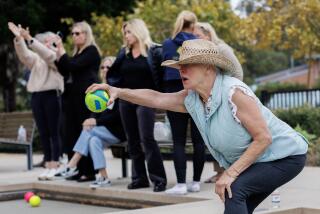French Roll Tense Game of Steely Concentration : Recreation: The Gallic passion for <i> petanque</i> , a form of bowling played outdoors with three metal balls, has been imported to West Los Angeles.
- Share via
It’s arguably the national pastime of France. Wherever there’s a patch of flat dirt--in town squares, boulevard meridians, public parks, campgrounds-- petanque players gather.
All they’re really doing is trying to toss or roll three steel balls as close to a marker as possible. But that process brings out at least as much passion, strategy, animated gesturing, spirited banter and joie de vivre among the French as do politics or haute cuisine.
So it’s no surprise that French “petanquers” living in Los Angeles have staked out a patch of Southern California dirt to carry on their passion. They gather every Saturday and occasional Sundays in Rancho Park in West Los Angeles, transforming a niche of the park--tucked between the archery range and a maintenance shed--into a parcel of their homeland.
But the mostly French contingent that gathers in Rancho Park isn’t there to indulge in nostalgia for their country. They’re there to play petanque.
Pronounced “pay-tonk” (and also known as boules --pronounced “bools”), the game is similar to shuffleboard or horseshoes, and related to, but not the same as, English lawn bowling or Italian boccie ball.
A small round marker called a cochonnet, or jack, is tossed six to 10 meters away. Players then take turns tossing three steel boules as close as possible to the jack. The object is to finish a round with all three of one’s balls closer to the jack than any of the opponents’ balls. The game can be played tete-a-tete, or with teams of two or three.
That may sound rather tame, but when strategy kicks in, the game shifts into high gear. For example, in three-on-three petanque, each player assumes a specialist role. The first player, called the pointeur, uses a deft backhand toss to place his or her ball close to the cochonnet. Backspin prevents the ball from rolling too far.
The second player, the milieur, may attempt to better the opponents’ position relative to the jack, or may elect to bump a boule out of scoring contention. The third player is the tireur, the marksman, who specializes in bumping opponents’ balls.
The tireur’s ability usually makes the difference in a petanque match. Even a casual onlooker can marvel at the skill of a good tireur as he concentrates on a target--an enemy boule lying close to the jack--then launches a toss high in the air. Steel on steel produces a loud clink as the target boule ricochets away. The tireur’s own boule may plop right down in place of the other. Even if it doesn’t, he has cleared the way for his team to score.
At the end of a round, only the team with the boule closest to the jack scores. A measurement may be required. If the two closest boules belong to the same team, two points are scored, and if the three closest are of the same team, the maximum three points are scored. A full game may go to 15, or any predetermined number.
The petanquers who gather in Rancho Park are passionate about their sport, but they are just as enthusiastic about sharing it. One needn’t be daunted by all the French banter that accompanies petanque matches. The players all shift quickly into English when visitors inquire about the game.
Robert Breidenstein, president of the Los Angeles Petanque Club, says the group is trying to encourage Americans to play, so as to further the growth of the sport here.
“Sometimes on a Sunday when we have a tournament, we get pretty serious, but Saturdays are for training, for fun,” he said. “We always have extra balls and we always welcome visitors.”
Petanque clubs have formed in San Francisco and San Diego also, as well as in most major cities across the country. According to Breidenstein, about 500 players are registered with the Federation of Petanque, USA, and hundreds more play the game casually. Most are French, but the Los Angeles club also has members from Switzerland, Belgium, Italy, Canada and Poland.
The representation reflects the worldwide growth of the sport, which was played almost exclusively in the South of France until after World War II.
About 30 countries were represented at last month’s world championship in Spain, and prospects are good for petanque becoming a demonstration sport in the 1992 Olympics.
American petanque gained international prestige during the world tournament; a U.S. team that included two Los Angeles players finished 27th among 54 teams.
“Anyone can play petanque, “ says petanquer Max Le Grand. “That’s part of the beauty of the sport. Women, children, older people--it’s not strenuous, and it’s easy to learn.”
“But there’s a lot more going on than meets the eye,” adds Pierre Agnesse, a deadly tireur and member of the U.S. national team.
What clearly meets the eye of the petanque spectator is the camaraderie among the players. The game is clearly as much social as it is sport.
At a recent Sunday tournament that included San Francisco’s top team (which, incidentally, only narrowly defeated a team of Los Angeles women), picnic tables next to the courts were laden with pastries, baguette sandwiches and beverages. Nearly as much eating and socializing went on as petanque playing. And visitors were given a hearty bienvenue.
(Members of the Los Angeles Petanque Club gather in Rancho Park, near Motor Avenue and Pico Boulevard in West Los Angeles, every Saturday from about 10 a.m. until dark. The next Sunday tournament will be December 3.)
More to Read
Go beyond the scoreboard
Get the latest on L.A.'s teams in the daily Sports Report newsletter.
You may occasionally receive promotional content from the Los Angeles Times.










